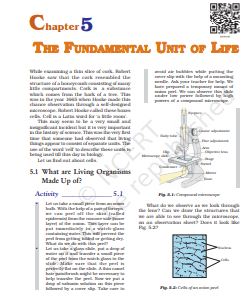‘NCERT Solutions for Class 9 Science Chapter 5‘ PDF Quick download link is given at the bottom of this article. You can see the PDF demo, size of the PDF, page numbers, and direct download Free PDF of ‘Ncert Class 9 Science Chapter 5 Exercise Solution’ using the download button.
NCERT Class 9 Science Textbook Chapter 5 With Answer PDF Free Download

Chapter 5: The Fundamental Unit of Life
While examining a thin slice of cork, Robert Hooke saw that the cork resembled the structure of a honeycomb consisting of many little compartments.
Cork is a substance that comes from the bark of a tree. This was in the year 1665 when Hooke made this chance observation through a self-designed microscope.
Robert Hooke called these boxes cells. The cell is a Latin word for ‘a little room’. This may seem to be a very small and insignificant incident but it is very important in the history of science.
This was the very first time that someone had observed that living things appear to consist of separate units. The use of the word ‘cell’ to describe these units is being used to this day in biology. Let us find out about cells.
What are these structures?
These structures look similar to each other. Together they form a big structure like an onion bulb! We find from this activity that onion bulbs of different sizes have similar small structures visible under a microscope.
The cells of the onion peel will all look the same, regardless of the size of the onion they came from. These small structures that we see are the basic building units of the onion bulb.
These structures are called cells. Not only onions but all organisms that we observe around are made up of cells. However, there are also single cells that live on their own.
5.2.1 Plasma Membrane Or Cell Membrane
This is the outermost covering of the cell that separates the contents of the cell from its external environment.
The plasma membrane allows or permits the entry and exit of some materials in and out of the cell. It also prevents the movement of some other materials.
The cell membrane, therefore, is called a selectively permeable membrane. How does the movement of substances take place in the cell?
How do substances move out of the cell? Some substances like carbon dioxide or oxygen can move across the cell membrane by a process called diffusion.
We have studied the process of diffusion in earlier chapters. We saw that there is a spontaneous movement of a substance from a region of high concentration to a region where its concentration is low.
Something similar to this happens in cells when, for example, some substance like CO2 (which is cellular waste and requires to be excreted out by the cell) accumulates in high concentrations inside the cell. In the cell’s external environment, the concentration of CO2 is low as compared to that inside the cell.
As soon as there is a difference in concentration of CO2 inside and outside a cell, CO2 moves out of the cell, from a region of high concentration to a region of low concentration outside the cell by the process of diffusion.
5.2.2 Cell Wall
Plant cells, in addition to the plasma membrane, have another rigid outer covering called the cell wall. The cell wall lies outside the plasma membrane.
The plant cell wall is mainly composed of cellulose. Cellulose is a complex substance and provides structural strength to plants.
When a living plant cell loses water through osmosis, there is shrinkage or contraction of the contents of the cell away from the cell wall.
This phenomenon is known as plasmolysis. We can observe this phenomenon by performing the following activity.
| Author | NCERT |
| Language | English |
| No. of Pages | 11 |
| PDF Size | 4.3 MB |
| Category | Science |
| Source/Credits | ncert.nic.in |
NCERT Solutions Class 9 Science Chapter 5 The Fundamental Unit of Life
1. Who discovered cells, and how?
Solution:
in 1665, Robert Hooke discovered cells while examining a thin slice of cork through a self-designed microscope. He observed that the cork resembled the structure of a honeycomb consisting of numerous tiny compartments. The minuscule boxes are referred to as cells.
2. Why is the cell called the structural and functional unit of life?
Solution:
Cells form the structure of an entity. A group of cells from a tissue, further an organ and ultimately an organ system.
They perform fundamental functions and life processes such as respiration, digestion, excretion, etc in both unicellular and multicellular entities. They perform all the activities independently. Hence, cells are referred to as structural and fundamental units of life.
3. How do substances like CO2 and water move in and out of the cell? Discuss.
Solution:
CO2 moves by diffusion – This cellular waste accumulates in high concentrations in the cell, whereas the concentration of CO2 in the external surroundings is comparatively lower.
This difference in the concentration level inside and out of the cell causes the CO2 to diffuse from a region higher(within the cell) to a lower concentration.
H2O diffuses by osmosis through the cell membrane. It moves from a region of higher concentration to a lower concentrated region through a selectively permeable membrane until equilibrium is reached.
4. Why is the plasma membrane called a selectively permeable membrane?
Solution:
The plasma membrane is called a selectively permeable membrane as it permits the movement of only certain molecules in and out of the cells. Not all molecules are free to diffuse.
The Fundamental Unit of Life NCERT Textbook With Solutions PDF Free Download
